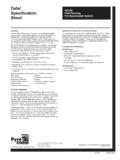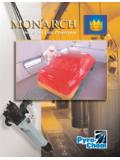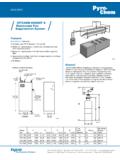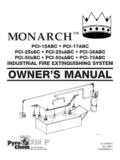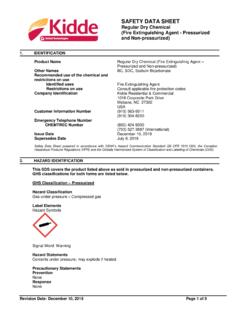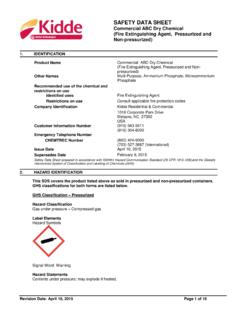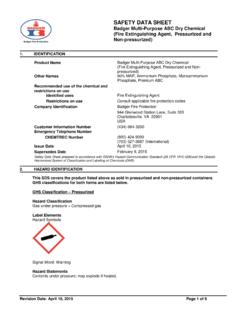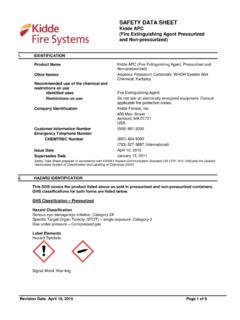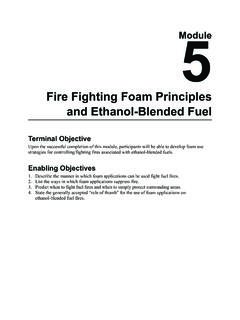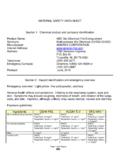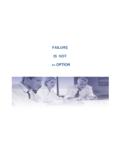Transcription of MONARCH Dry Chemical Automotive Paint Spray Booth …
1 One Stanton Street | Marinette, WI 54143-2542, USA | +1-715-735-7411 | 2018 Johnson Controls. All rights reserved. All specifications and other information shown were current as of document revision date and are subject to change without notice. | Form No. PC98231-05 DATA SHEETMONARCH Dry Chemical Automotive Paint Spray BoothFire Suppression SystemGeneralPaint Spray booths/rooms are areas designed to confine or limit the escape of Spray , vapor, and residue. A power ventila-tion system dedicated to these areas ensures the appropri-ate exhaust of residual material. PYRO-CHEM dry Chemical suppressing agents are appropriate for Class A, B, or C fires.
2 A careful hazard survey should be conducted to properly define the type of fire to be suppressed. In addition to flammable/combustible liquids, the material composition of the object to be painted must be considered as well as resident material in the protected area. Total flooding fire suppression techniques as defined by NFPA 17 are utilized by the Johnson Controls MONARCH fire suppression systems to protect the entire hazard which includes the work area, exhaust plenum area, pits, under floors, and exhaust National Fire Protection Association (NFPA) Standard No. 33 Spray Application Using Flammable and Combustible Materials, and No.
3 17 Dry Chemical Extinguishing Systems are primary reference sources and provide guidelines for the proper application and design of MONARCH Industrial Fire Suppression Systems in the specialized protection of Paint Spray booths and rooms. Underwriters Laboratories testing provides pre-engineered system application parameters allowing the flex-ibility to protect a variety of Paint Spray Booth /room layouts to Underwriter s Standard UL 1254, effective September 1998, with OperationPaint Spray Booth fire protection is a special application of the MONARCH Industrial Fire Suppression System.
4 It provides a highly reliable response with the versatility of automatic or manual modular concept of protection is used. A nozzle, with a prescribed area of protection positioned according to pre-engi-neered placement parameters, protects a modular area of the hazard. Sets of nozzles supplied by a dedicated cylinder contain-ing dry Chemical suppressing agent and piped in an approved pattern consistent with the application coverage are utilized. Mechanical or electrical fixed temperature detectors are posi-tioned strategically within the protected area to monitor ambient temperature and initiate an output should the rated tempera-ture be exceeded.
5 The detector input is sensed at the control head. The control head responds by discharging the system by pneumatically depressing the stored agent cylinder valve. The system is provided with a time delay device to allow for fan shut down before agent discharge. A manual means of activating the system is also capability is available to provide remote manual acti-vation, auxiliary electrical outputs and/or audible alarms. This optional equipment will enhance the basic system functions and be applicable when designing custom configurations to suit a particular customer s needs and/or comply with local codes.
6 1. Fixed temperature mechanical or electrical thermal detectors 2. Electrical conduit protecting stainless steel cable 3. Model MCH Control Head 4. Pneumatic copper tubing and/or stainless steel hose 5. Model PCI-Series agent Storage Cylinders 6. Fixed agent distribution piping 7. Suppressing agent Discharge Nozzles 8. Alarm Bell 9. Time Delay10. Model RPS-M Remote Mechanical Pull StationSuggested Architect s Specifications1. General The fire suppression system shall be the stored pres-sure dry Chemical pre-engineered fixed nozzle type manu-factured by Johnson Controls.
7 The system shall provide for the protection of the Paint Spray area(s) described in drawing _____. (Note drawing number and revision.) The system shall be capable of automatic and manual actuation. It shall be UL Listed and installed in conformance with NFPA Standard No. 17, Dry Chem ical Extinguishing Systems and No. 33, Spray Application using Flammable and Combustible Materials, and comply with all local and/or state Codes and Standards. The system shall be designed for operation at ambient temperatures from 32 F to 120 F (0 C to 49 C).2. Cylinder and agent agent .
8 The system shall use PYRO-CHEM monoam-monium phosphate-based dry Chemical Architect s Specifications (Continued)2. Cylinder and agent (Continued) Cylinders. Steel cylinders manufactured, tested, and marked in accordance with DOT 4B 350 or DOT 4B 500 shall be used to store the suppressing agent as listed:Model lb (kg)PCI-15 ABC ( )PCI-17 ABC 17 ( )PCI-25sABC 25 ( )PCI-35 ABC 35 ( )PCI-70 ABC 70 ( ) All models shall be charged with dry nitrogen to 350 psig at 70 F (24 bar at 21 C). Cylinder valve. A pressure sealed poppet-type valve having a brass body, stainless steel stem with rubber seat washer, fusible safety relief assembly, and pressure gauge shall be used on all agent cylinders.
9 Cylinder bracketing. Cylinders shall be mounted verti-cally. The cylinders shall be secured by use of a steel mount-ing bracket affixed to a rigid object capable of supporting the weight of the filled cylinder and the concussion of cylinder Actuation Controls Control Head. The system shall include a Model MCH, NMCH or ECH-Series Control Head. The control head shall be mounted directly on the time delay in a Model MB-P2 control-head mounting bracket. The control head can actuate up to five centrally located agent cylinders. A carbon dioxide pilot cartridge that complies with MIL-C0601G shall be used as an integral component of the control head.
10 Control head status shall be visually indicated by a SET/FIRED indicator. Time Delay. The system shall have a Model TD-10 Time Delay to allow for fan shut down before agent discharge. Detection. The ambient temperature of the hazard area shall be monitored by fixed temperature mechanical or elec-trical thermal detectors. When the temperature of the hazard area exceeds the rating of any detector, the detector shall a) release tension in a cable connected to the control head, causing control head activation (for mechanical detectors), or b) close a normally open switch element within the detec-tor, sending a signal to the control head which energizes a solenoid in the control head, exercising the control head (for electrical detectors).

